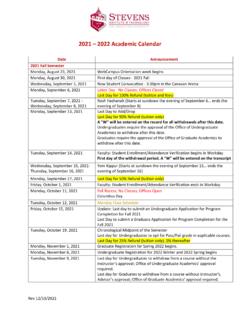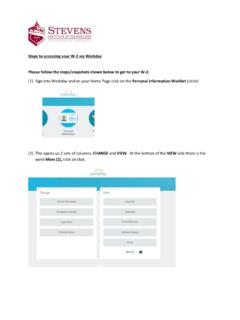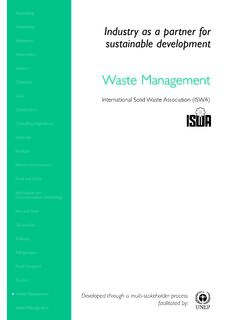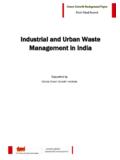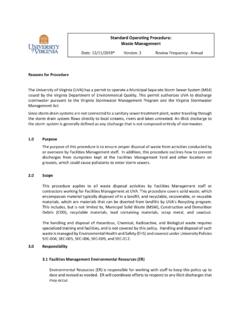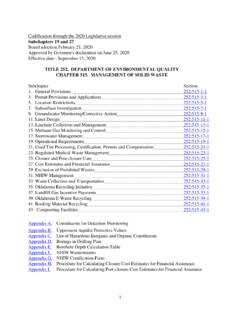Transcription of WASTE MANAGEMENT PLAN - Stevens Institute of …
1 WASTE MANAGEMENT plan for Stevens Institute of Technology Castle Point on Hudson Hoboken, New Jersey 07030-5991. Prepared By: Tetra Tech EC. 1000 The American Road Morris Plains, New Jersey 07950. March 25, 2011. i Stevens Institute OF TECHNOLOGY. WASTE MANAGEMENT plan Table of Contents Page WASTE MANAGEMENT Flow Diagram ..iii INTRODUCTION ..1. How to Use the WASTE MANAGEMENT plan ..1. WASTE MANAGEMENT REQUIREMENTS BY WASTE TYPE ..1. Chemical WASTE ..1. Identification ..1. Classification ..2. Storage and Handling ..5. Disposal ..8. HAZARDOUS WASTE DISPOSAL ..8. NON-HAZARDOUS WASTE DISPOSAL ..8. Empty Containers ..8. Special WASTE ..9. Identification ..9. Storage, Handling and disposal ..9. USED KITCHEN GREASE ..9. USED OIL ..9. Universal WASTE .. 10. Identification .. 10. Storage and Handling .. 10. USED FLUORESCENT BULBS .. 10. USED LEAD ACID & METAL HYDRIDE BATTERIES, & USED .. 11. USED MERCURYR CONTAINING SWITCHES.
2 11. CONSUMER ELECTRONICS, INCLUDING COMPUTERS .. 11. LIGHT BALLASTS .. 11. Disposal .. 13. Red Bag/Regulated Medical WASTE .. 13. Identification .. 13. Storage and Handling .. 13. SHARPS AND BIOHAZARD GLASSWARE .. 14. PRESERVED ANIMAL CARCASSES .. 14. NON-PRESERVED ANIMAL CARCASSES .. 14. INFECTIOUS BIOLOGICAL MATERIAL .. 14. Disposal Requirements .. 15. SHARPS AND BIOHAZARD GLASSWARE .. 15. PRESERVED ANIMAL CARCASSES .. 15. NON-PRESERVED ANIMAL CARCASSES .. 15. INFECTIOUS BIOLOGICAL MATERIAL .. 15. Radiological WASTE .. 16. Identification .. 16. Storage and Handling and Disposal .. 16. Regular Trash .. 17. Identification .. 17. Storage, Handling, and 17. RECYCLABLE WASTES .. 17. NON-RECYCLABLE WASTES .. 17. i LIST OF APPENDICES. Appendix A Administration Contacts 18. Appendix B Toxicity Characteristic Wastes ..19. Appendix C Listed Hazardous Wastes ..20. F-Listed Wastes 20. U-Listed Wastes ..23. P-Listed Wastes 34. Appendix D Hazardous WASTE Storage Area Weekly Inspection Checklist.
3 39. ii WASTE MANAGEMENT Flow Diagram When a Material is No Longer Needed or Wanted it is a DECLARED WASTE . Types of DELCARED WASTE . at Stevens Institute of Technology Chemical WASTE Special WASTE Universal WASTE Red Bag/Medical Radiological Regular Recycling WASTE Wastes Trash Universal WASTE Includes: Regulated Medical WASTE Includes: * Used Lead-Acid Batteries or metal * Sharps & Biohazard Glassware hydride batteries * Preserved Animal Carcasses Recycling Includes: * Mercury Thermostats For WASTE * Non-preserved Animal Carcasses For * Alkaline Batteries * Used Fluorescent Bulbs Storage/Disposal Chemicals Empty Used Kitchen * Infectious Biological Material Storage/Disposal * Carbon Steel Batteries Used Oil * Used CRTs & Computer Components Requirements, go (Liquid/Solid) Containers Grease (including blood, blood products, of P-32, S-35, & * Plastics * PCB Ballasts to Page 17. culture and stocks) I-125 WASTE , go to * Paper Page 15 * Metal Cans Has Oil Been Contaminated To Classify, go to With Solvents, Antifreeze or Page 2 Other Materials?
4 For For For Storage/Disposal For Storage/Disposal Storage/Disposal Storage/Disposal Requirements, go to Requirements, go to Requirements, go Requirements, go Yes No Pages 10 - 12 Pages 13 - 15 For to Page 8 to Page 9 Storage/Disposal For For Requirements, go Storage/Disposal Storage/Disposal to Page 17. Requirements, go Requirements, go to Page 5/7 to Page 9. Hazardous WASTE Non-Hazardous Chemicals WASTE Chemicals For For Storage/Disposal Storage/Disposal Requirements, go Requirements, go to Page 5/7 to Page 7/8. iii Stevens Institute OF TECHNOLOGY. WASTE MANAGEMENT plan . INTRODUCTION. How to Use the WASTE MANAGEMENT plan This WASTE MANAGEMENT plan is intended to provide a roadmap for the proper MANAGEMENT of wastes generated at Stevens Institute of Technology ( Stevens ). It contains both requirements of state and federal environmental law as well as University policies. The WASTE MANAGEMENT Flow Diagram serves as the starting point for using the plan .
5 University generated wastes are divided into the following 7 categories: Chemical Wastes;. Special Wastes;. Universal Wastes;. Red Bag/Medical WASTE ;. Radiological WASTE ;. Regular Trash*; and, Recycled Wastes. Brief descriptions of each WASTE type are contained within the Diagram. Once you have located your particular WASTE , the Diagram will indicate the page on which the requirements for handling, storage and disposal are located. The plan is maintained by the University's Environmental Health and Safety Department. Questions regarding the content or use of the plan should be directed to David Fernandez, Director EHS (A list of names of people responsible for implementing this WASTE MANAGEMENT plan may be found in Appendix A.). WASTE MANAGEMENT REQUIREMENTS BY WASTE TYPE. Chemical WASTE Identification In accordance with Stevens ' WASTE MANAGEMENT plan , any chemical substance, *Construction and demolition debris are handled on a project-specific basis.
6 1. or mixture of chemical substances that you have decided to discard (and can not be used or reused by another party) is known as a chemical WASTE . This can include chemicals that are intended to be disposed of and chemicals that are being stored but are no longer used or needed. Chemical wastes can be in liquid, solid or gaseous form. Classification All chemical wastes generated at the University must be evaluated to determine if they would be considered to be hazardous WASTE or non-hazardous WASTE . Hazardous wastes are a group of wastes classified by the United States Environmental Protection Agency (USEPA) and New Jersey Department of Environmental Protection (NJDEP) as requiring special handling and disposal due to their potential to harm human health and the environment. Review each of the following to determine if your chemical WASTE is a hazardous WASTE . Hazardous WASTE There are two ways that a chemical WASTE may be a hazardous WASTE .
7 The first is if the WASTE exhibits certain characteristics based either on your knowledge of the WASTE or by testing the WASTE . These are known as Characteristic Hazardous Wastes. The second is if the USEPA specifically lists the WASTE as a hazardous WASTE . These are known as Listed Hazardous Wastes. Based on these criteria, it is critical that you understand how your chemical WASTE was generated and what the components of the WASTE are. This information is used by the WASTE Disposal Contractor to dispose of the WASTE . (a) Characteristic Hazardous Wastes Characteristic hazardous wastes are divided into the following categories: Ignitable hazardous WASTE ;. Corrosive hazardous WASTE ;. Reactive hazardous WASTE ; and, Toxic hazardous WASTE . (a)(1) Ignitable Hazardous WASTE Ignitable hazardous wastes are wastes that readily catch fire and can sustain combustion. Wastes are ignitable, as defined by USEPA, if they are liquids and have a flash point of less than 60oC (140oF).
8 Other ignitable wastes include oxidizers such as chlorates, permanganates, inorganic peroxides, or nitrates/nitrites that liberate oxygen readily to promote the combustion of organic matter. Also ignitable are flammable compressed gases, and wastes that are not liquid at 20oC (68oF) that are spontaneously combustible. Wastes exhibiting the characteristic of ignitability are assigned the WASTE code D001. Examples of Ignitable Hazardous WASTE found at Stevens include: Used acetone solutions Used ethanol or methanol solutions Used xylene solutions Note: Some examples may fit into more than one WASTE category. 2. (a)(2) Corrosive Hazardous WASTE Corrosive hazardous wastes are either acidic or alkaline (basic) wastes that can readily corrode or dissolve metal, skin or other materials. USEPA classifies a WASTE as corrosive if it is aqueous and it has a pH of or less, or a pH that's or greater. Wastes exhibiting the characteristic of corrosivity are assigned the WASTE code D002.
9 Examples of Corrosive Hazardous WASTE found at Stevens include: Hydrochloric acid solutions Nitric acid solutions Sodium hydroxide solutions Note: Some examples may fit into more than one WASTE category. (a)(3) Reactive Hazardous WASTE A reactive hazardous WASTE , as defined by USEPA, is one that readily explodes or undergoes violent reactions. Wastes that react violently with water, such as pure sodium metal or wastes that form potentially explosive mixtures with water are considered reactive. In addition, wastes that contain cyanides or sulfides that can release toxic gases when exposed to acid or basic conditions are also considered reactive. Wastes exhibiting the characteristic of reactivity are assigned the WASTE code D003. Examples of Reactive Hazardous WASTE found at Stevens include: Metallic sodium or potassium WASTE concentrated bleaches Cyanide containing salts Note: Some examples may fit into more than one WASTE category.
10 (a)(4) Toxic Hazardous WASTE Toxicity characteristic wastes are determined by use of a standardized test method. This method, known as the Toxicity Characteristic Leaching Procedure (TCLP), is designed to simulate the leaching of toxic landfill wastes into groundwater. USEPA considers wastes to have the characteristic of toxicity if they have the potential of leaching any of 39. constituents in levels at or above specific TCLP threshold levels. Wastes displaying the characteristic of toxicity can carry any of the WASTE codes D004 to D043. The codes include 8 heavy metals, 4 insecticides, 2 herbicides, and 25 other organic compounds (see Appendix B for a list of toxicity characteristic (TC) wastes and their threshold levels). 3. Examples of Toxicity Characteristic Hazardous WASTE found at Stevens include: Mercury, silver or lead salt solutions Benzene solutions Chromium solutions Note: Some examples may fit into more than one WASTE category.





